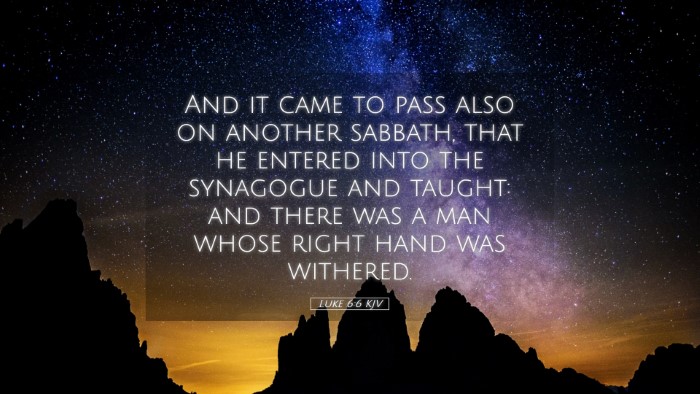Commentary on Luke 6:6
Verse: "And it came to pass also on another sabbath, that he entered into the synagogue and taught: and there was a man whose right hand was withered." (Luke 6:6 KJV)
Introduction
This passage occurs during a pivotal moment in the ministry of Jesus, marking significant tensions between Him and the religious authorities of the time. The withered hand of the man symbolizes not only physical affliction but also the greater spiritual condition of the people.
Contextual Background
Matthew Henry emphasizes the importance of this setting, noting that Jesus performed this miracle on the Sabbath, a day meticulously observed by Jewish law. The contrast between the law's rigidity and Christ's compassionate fulfillment of the law is palpable.
In the synagogues, various teachings and interpretations were shared, and this occasion provides a direct opportunity for Jesus to reveal His authority and purpose.
The Presence of Christ
Albert Barnes notes the significance of Jesus' presence in the synagogue. His prophetic teaching and miraculous powers drew the attention of both followers and dissenters. Here, He engages with a man stricken by physical disability, reflecting His compassionate nature.
Jesus’ actions reveal a deeper theological truth — that the Sabbath was made for man, not man for the Sabbath (Mark 2:27). This aligns with the understanding that mercy and healing are intrinsic to God's nature, especially in times of need.
The Withered Hand
Adam Clarke elaborates on the symbolism of the withered hand. The right hand, being a symbol of strength and dexterity, illustrates the complete incapacitation that sin can impose on an individual. This man's condition signifies a life not fully experiencing God's intended purpose—restricted and unfulfilled.
In a broader sense, the withered hand represents all humanity's struggles with spiritual barrenness. Just as the man’s physical ailment hindered him, so too does sin inhibit individuals from reaching their divine potential.
Reaction of the Pharisees
This passage unveils the expected response of the Pharisees. They were already predetermined to question Jesus’ actions based on the law, as pointed out by Henry. Their focus on legalistic interpretations overshadowed the essence of compassion and mercy embodied in Christ's ministry.
- Legalism vs. Mercy: The Pharisees represent the danger of being so engrossed in rule-keeping that one neglects the spirit of the law.
- Spiritual Blindness: Their incapacity to recognize the miracle amongst them displays a deep-seated spiritual blindness, which can be a cautionary tale for modern believers.
Jesus’ Authority to Heal
In this scenario, Jesus intentionally calls attention to the man with the withered hand. Barnes comments on the boldness of His approach—He not only acknowledges the man but declares the intention to heal him publicly, further challenging the Pharisees' rigid stance on the Sabbath.
Jesus' question, “Is it lawful on the sabbath days to do good, or to do evil?” (Luke 6:9) provokes introspection among the listeners. This query transcends the specifics of the day’s observance and propels a critical discussion on ethics, morality, and divine love.
The Healing Miracle
The miracle itself is simple yet profound. Upon healing the man, Jesus restores both physical ability and social inclusion. Henry notes that this act goes beyond mere healing; it signifies Jesus' recognition of the man's dignity and worth.
As the man stretches out his hand, he symbolizes all who reach out in faith, trusting in Jesus’ power to restore and heal. The immediacy of his healing reflects Christ's authority over physical and spiritual ailments alike.
Theological Implications
This passage reminds us that the ministry of Christ challenges and redefines the human understanding of law and grace. Adam Clarke points out the profound theological significance of Jesus healing on the Sabbath — it illustrates the freedom found in Christ, breaking religious chains that bind the spirit.
Furthermore, this event underscores the power of faith manifested through action. The man with the withered hand took the risk of following Jesus’ command, which ultimately led to his restoration.
Conclusion
Luke 6:6 serves as an important reminder for pastors, theologians, and students of the Word about the nature of Jesus’ mission. The intersection of law, mercy, and healing stands at the heart of the Gospel message. It highlights the necessity for believers to embody compassion and to understand the importance of grace in their spiritual journey.
Let this passage prompt ongoing reflection on how we respond to the needs of others, especially in contexts that challenge our understanding of the 'rules' we uphold. May we, like the man with the withered hand, have the courage to stretch out our own hands to receive the healing and restoration that Christ freely offers.


